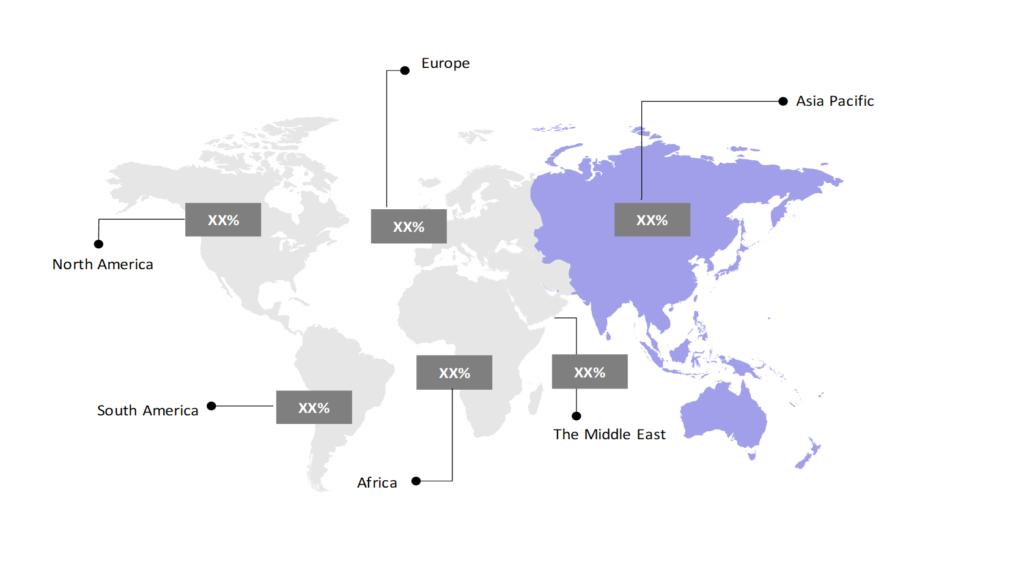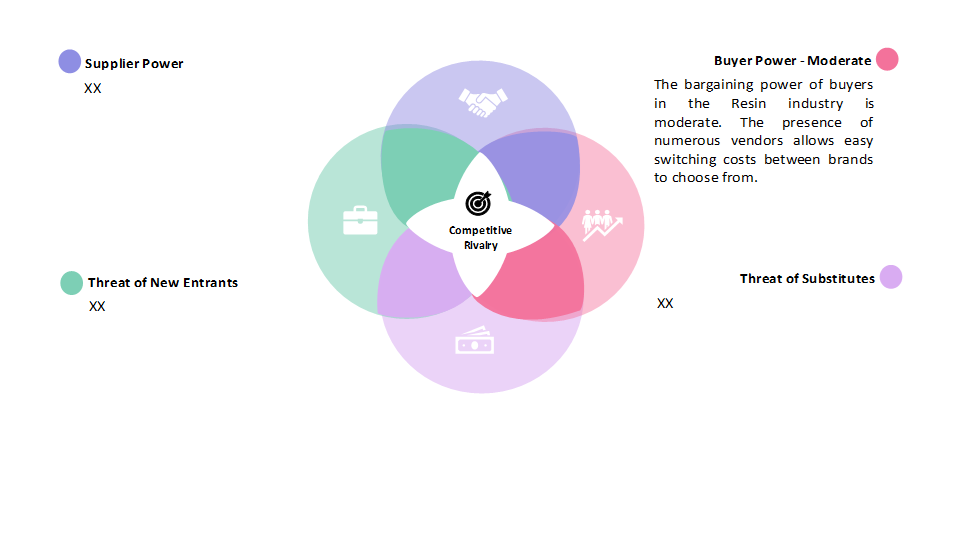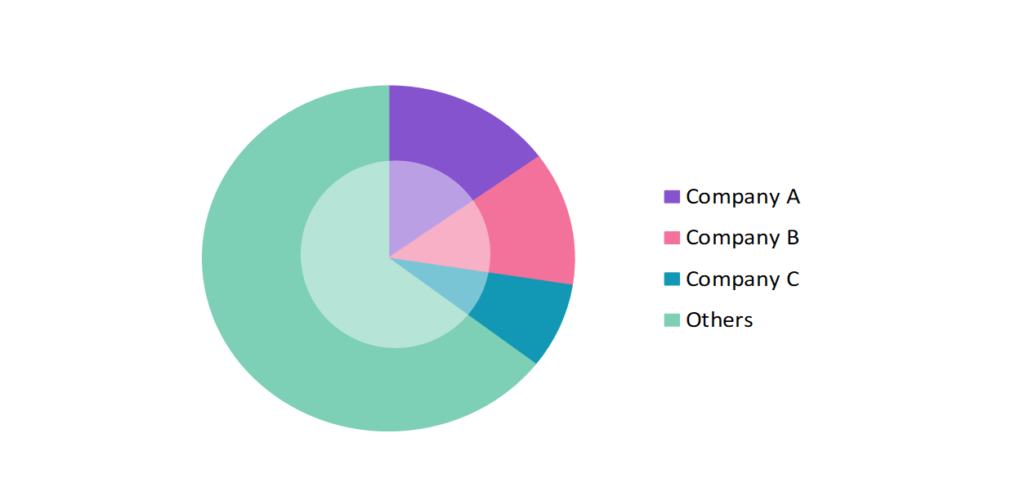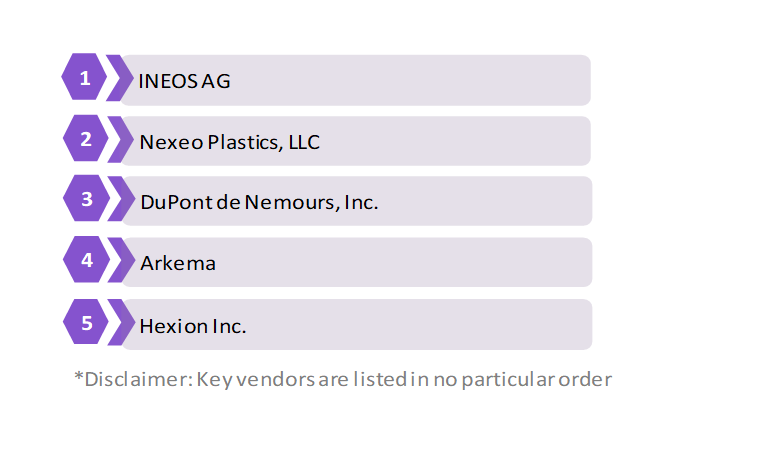Resin Market Analysis: Growth, Size, Share & Future Trends (2024-2029)
The report covers a comprehensive analysis segmented by Type (Polyethylene, Polypropylene, Polyvinyl Chloride, Polyamide, Polycarbonate, Others), by Products (Floor coverings, Pharmaceuticals, Paints, Chemicals, Others), by Distribution Channel (Retailers, Wholesalers, Online Platforms, Others), by End-user (Packaging, Automotive & Transportation, Building & Construction, Electrical & Electronics, Agriculture, Others), by Geography (North America, South America, Asia Pacific, Europe, the Middle East, Africa).
Resin Market Snapshot

Resin Market Overview
The global Resin market is estimated to be at $728.39 Bn in 2024 and is anticipated to reach $942.05 Bn in 2029. The global resin market is registering a CAGR of 5.28% during the forecast period 2024-2029.
Natural resins are plant secretions that harden when exposed to air, while synthetic resins are man-made polymers. Both types are used in various industries for adhesives, coatings, and manufacturing. The global resin market has been experiencing steady growth over the years, driven by increasing demand from end-use industries. Factors such as urbanization, infrastructure development, automotive production, and technological advancements contribute to market expansion. The market is influenced by regional factors, economic conditions, and regulatory policies. Various types of resin are available, each with unique properties and applications.
Epoxy, polyester, polyurethane, acrylic, vinyl ester, and many other resins cater to different needs across industries. Resins find applications in a wide range of industries. For example, resins are used in coatings, adhesives, sealants, and composite materials for building and infrastructure projects. They are used in packaging, healthcare, automotive coatings, adhesives, composites, and interior components to enhance performance and aesthetics. The resin industry is characterized by continuous innovation and technological advancements. There is an increasing demand for resins with superior mechanical properties, chemical resistance, and thermal stability to meet the requirements of specialized applications. The resin market is poised for continued growth and innovation, driven by evolving industry requirements, technological advancements, and sustainability goals.
Resin Market Coverage
| Historical & Forecast Period | 2018-2029 |
| Base Year | 2023 |
| Forecast Period | 2024-2029 |
| Units | Billion US$ |
| Segments | Type, Products, Distribution Channel, End-user |
| Geographies | North America, South America, Asia Pacific, Europe, The Middle East, Africa |
| Key Vendors | INEOS AG, Nexeo Plastics, LLC, DuPont de Nemours, Inc., Arkema, Hexion Inc. |
Key Geographies of Resin Market, 2023

Porter’s 5 Forces Analysis of Resin Market

Resin Market Trends
Resins are increasingly being used in advanced applications such as 3D printing, where the demand for high-performance resins with specific properties like heat resistance and durability is rising. For example, Formlabs offers a range of specialized resins for various 3D printing applications, including engineering, dental, and jewelry. Resins play a critical role in the electronics and electrical industry, where they are used as encapsulants, adhesives, and coatings to protect electronic components from moisture, chemicals, and mechanical stress.
With the miniaturization of electronic devices and the proliferation of wearable technology and Internet of Things (IoT) devices, there’s a growing demand for high-performance resins with excellent electrical insulation properties, thermal conductivity, and reliability. Resins are increasingly being utilized in advanced applications across various industries, such as aerospace, automotive, electronics, and healthcare. This trend is driven by the need for lightweight materials with high strength-to-weight ratios, excellent chemical resistance, and thermal stability. With growing environmental concerns, there’s a push towards developing bio-based resins derived from renewable sources such as plant-based materials or waste streams. Manufacturers are also exploring recyclable and biodegradable resin options to reduce their environmental impact. Resins are widely used in the healthcare and medical device industries for applications such as medical implants, surgical instruments, and diagnostic equipment. Biocompatible resins that meet regulatory requirements for biocompatibility and sterilization are in high demand. Additionally, there’s a growing interest in antimicrobial and drug-eluting resins for use in medical applications to prevent infections and improve patient outcomes. The resin industry is embracing digitalization and Industry 4.0 technologies to improve manufacturing processes, enhance product quality, and optimize supply chain management. Advanced digital modeling and simulation tools are being used for resin formulation and process optimization, resulting in the development of tailored resin solutions with optimized performance characteristics.
Resin Market Driving Factors
Resin demand is closely tied to industrial growth, as it’s used in a wide range of industries such as construction, automotive, electronics, packaging, and aerospace. Economic expansion, particularly in emerging markets, drives demand for products like adhesives, coatings, and composites, all of which use resin as a key component. As the automotive industry expands, driven by factors like technological advancements, consumer demand for fuel efficiency, and electric vehicle adoption, the demand for epoxy resin in this sector grows. For instance, epoxy resin is increasingly utilized in automotive components due to its lightweight nature, strength, and resistance to corrosion.
The demand for resin is heavily influenced by various end-user industries, such as construction, electronics, packaging, and aerospace. Economic growth, consumer spending, and technological advancements in these sectors drive the demand for resin-based products. The availability and cost of raw materials used in resin production, such as petrochemicals, natural gas, and renewable resources like plant-based feedstocks, significantly impact the resin market. The cost and profitability of production can be impacted by changes in the price of raw materials. Product development and market expansion are propelled by advancements in resin chemistry, production procedures, and application strategies. The possible applications and performance qualities of resin products are expanded by technological advancements including 3D printing, nanotechnology, and bio-based resins. Macroeconomic variables that affect the resin business include GDP growth, inflation, interest rates, and currency exchange rates. These factors also impact investment decisions and market demand.
Resin Market Challenges
The global resin market faces several challenges related to government regulations. These regulations impact various aspects of the resin production process, from raw material procurement to manufacturing, usage, and disposal. Governments worldwide are implementing stringent emission standards to reduce the environmental impact of resin manufacturing. These regulations often require companies to invest in cleaner technologies and adopt practices that minimize volatile organic compounds (VOCs) and other pollutants. For example, regulations like the European Union’s REACH (Registration, Evaluation, Authorization, and Restriction of Chemicals) and similar laws in other regions require comprehensive safety assessments of chemicals used in resin production.
Resins typically require specific curing conditions, such as temperature, humidity, and time, to achieve optimal properties. Controlling these parameters can be challenging, especially in large-scale manufacturing processes where uniformity is crucial. Improper disposal of resin waste can also lead to soil and water contamination. Resin production often involves the use of petrochemicals and can result in emissions of volatile organic compounds (VOCs), which contribute to air pollution and climate change. Improper disposal of resin waste can also lead to soil and water contamination. For instance, a manufacturer of epoxy resin coatings implements a sustainability initiative to reduce VOC emissions by switching to low-VOC formulations and investing in waste management practices such as recycling and proper disposal. A lot of resins shrink when they cure, which can cause dimensional changes and even warping in molded items. Maintaining the dimensional correctness and structural integrity of completed items requires minimizing shrinkage and managing warping. The overall economics of resin-based production can be impacted by the cost of personnel, processing equipment, and raw materials. To be competitive in the market, one must retain scalability while balancing cost and performance needs. It can be difficult to provide adequate adhesion between resin-based materials and substrates, particularly when bonding incompatible materials or handling surface impurities. Achieving strong and long-lasting connections requires careful consideration of adhesive selection and surface preparation methods.
Resin Market – Key Industry News
- About USD 135 million will be invested over the course of the next few years by DCM Shriram to construct a greenfield plant that will produce epoxy resin in February 2024.
- INEOS Styrolution announced in March 2023 that major Asian home appliance makers would be bringing K-Resin KR21 to market.
- In December 2023, Grasim Industries Limited commissioned the expansion of its epoxy resins and formulation capacity at Vilayat, Gujarat.
Resin Market Competitive Landscape
The global resin industry participants always develop strategies to preserve a competitive advantage. The competitive landscape of the resin industry is dynamic and multifaceted, with various factors influencing market dynamics, such as product innovation, pricing strategies, geographic reach, and customer relationships. Manufacturers like Dow Chemical Company, BASF SE, and DuPont have historically dominated the resin market. They have extensive product portfolios, global reach, and strong brand recognition. Several regional players operate in specific geographical areas, catering to local demand and preferences. For instance, in Asia-Pacific, companies like Formosa Plastics Corporation and LG Chem have a significant presence, leveraging proximity to key markets and lower production costs. The companies primarily use acquisitions, R&D, partnerships, and technological launches. Several important entities in the resin market include INEOS AG, Nexeo Plastics, LLC, DuPont de Nemours, Inc., Arkema, Hexion Inc., and others.
Resin Market Company Share Analysis, 2023 (%)

Resin Market – Key Companies

Reason to Buy from us

Table of Contents
| 1. Introduction |
|---|
| 1.1. Research Methodology |
| 1.2. Scope of the Study |
| 2. Market Overview / Executive Summary |
| 2.1. Global Resin Market (2018 – 2022) |
| 2.2. Global Resin Market (2023 – 2029) |
| 3. Market Segmentation |
| 3.1. Global Resin Market by Type |
| 3.1.1. Polyethylene |
| 3.1.2. Polypropylene |
| 3.1.3. Polyvinyl Chloride |
| 3.1.4. Polyamide |
| 3.1.5. Polycarbonate |
| 3.1.6. Others |
| 3.2. Global Resin Market by Products |
| 3.2.1. Floor coverings |
| 3.2.2. Pharmaceuticals |
| 3.2.3. Paints |
| 3.2.4. Chemicals |
| 3.2.5. Others |
| 3.3. Global Resin Market by Distribution Channel |
| 3.3.1. Retailers |
| 3.3.2. Wholesalers |
| 3.3.3. Online Platforms |
| 3.3.4. Others |
| 3.4. Global Resin Market by End-user |
| 3.4.1. Packaging |
| 3.4.2. Automotive & Transportation |
| 3.4.3. Building & Construction |
| 3.4.4. Electrical & Electronics |
| 3.4.5. Agriculture |
| 3.4.6. Others |
| 4. Regional Segmentation |
| 4.1. North America |
| 4.1.1. The U.S |
| 4.1.2. Canada |
| 4.1.3. Mexico |
| 4.2. South America |
| 4.2.1. Brazil |
| 4.2.2. Argentina |
| 4.2.3. Colombia |
| 4.2.4. Chile |
| 4.2.5. Rest of South America |
| 4.3. Asia Pacific |
| 4.3.1. China |
| 4.3.2. India |
| 4.3.3. Japan |
| 4.3.4. South Korea |
| 4.3.5. Rest of Asia Pacific |
| 4.4. Europe |
| 4.4.1. UK |
| 4.4.2. Germany |
| 4.4.3. Italy |
| 4.4.4. France |
| 4.4.5. Spain |
| 4.4.6. Rest of Europe |
| 4.5. The Middle East |
| 4.5.1. Turkey |
| 4.5.2. UAE |
| 4.5.3. Saudi Arabia |
| 4.5.4. Rest of the Middle East |
| 4.6. Africa |
| 4.6.1. Egypt |
| 4.6.2. South Africa |
| 4.6.3. Rest of Africa |
| 5. Value Chain Analysis of the Global Resin Market |
| 6. Porter Five Forces Analysis |
| 6.1. Threats of New Entrants |
| 6.2. Threats of Substitutes |
| 6.3. Bargaining Power of Buyers |
| 6.4. Bargaining Power of Suppliers |
| 6.5. Competition in the Industry |
| 7. Trends, Drivers and Challenges Analysis |
| 7.1. Market Trends |
| 7.1.1. Market Trend 1 |
| 7.1.2. Market Trend 2 |
| 7.1.3. Market Trend 3 |
| 7.2. Market Drivers |
| 7.2.1. Market Driver 1 |
| 7.2.2. Market Driver 2 |
| 7.2.3. Market Driver 3 |
| 7.3. Market Challenges |
| 7.3.1. Market Challenge 1 |
| 7.3.2. Market Challenge 2 |
| 7.3.3. Market Challenge 3 |
| 8. Regulatory Landscape |
| 9. Competitive Landscape |
| 9.1. INEOS AG |
| 9.2. Nexeo Plastics, LLC |
| 9.3. DuPont de Nemours, Inc. |
| 9.4. Arkema |
| 9.5. Hexion Inc. |
| 9.6. Company 6 |
| 9.7. Company 7 |
| 9.8. Company 8 |
| 9.9. Company 9 |
| 9.10. Company 10 |
Resin Market – Frequently Asked Questions (FAQs)
What is the current size of the global resin market?
The market size for the global resin market in 2024 is $728.39 Bn.
Who are the major vendors in the global resin market?
The major vendors in the global resin market are INEOS AG, Nexeo Plastics, LLC, DuPont de Nemours, Inc., Arkema, and Hexion Inc.
Which segments are covered under the global resin market segments analysis?
This report offers in-depth insights into each type, product, distribution channel, and end-user.
